Services on Demand
Article
Related links
Share
RSBO (Online)
On-line version ISSN 1984-5685
RSBO (Online) vol.13 n.4 Joinville Oct./Dec. 2016
CASE REPORT ARTICLE
Esthetic rehabilitation of anterior teeth through gingival recontouring and ceramic veneers: a case report
Orides Ferrari Jr.I; Fernando DalitzI; Marina Samara BaechtoldI; Ubiracy GaiãoII; Leonardo Fernandes da CunhaI,II; Carla Castiglia GonzagaI,II; Gisele Maria CorrerI,II
I Program of Post-Graduation in Dentistry, Positivo University – Curitiba – PR – Brazil
II Specialization in Operative Dentistry, Positivo University – Curitiba – PR – Brazil
ABSTRACT
Introduction: Esthetic rehabilitations require a broad and thorough evaluation of all the elements that make up the smile such as lips, dental, and periodontal structures to plan the treatment to provide harmony to the whole set. Objective: To demonstrate through a case the association of Periodontics and Restorative Dentistry in the esthetic rehabilitation of anterior teeth replacing resin restorations by modifying the gingival architecture conservatively and harmonically. Case report: It is essential for a multidisciplinary approach to succeed in treatment. The replacement of previous restorations is an increasing demand in currently clinical practice, for many reasons, mainly due to dissatisfaction with the esthetics. It is observed that many of these patients involve not only dissatisfaction with the dental structure but also with the periodontal health, for this reason, it is necessary a previous adaptation of the gingival tissues for proper restorative rehabilitation. Conclusion: Ceramic laminates have proved to be a great choice for anterior teeth restorations, but they must be indicated in specific situations, to obtain excellent results as most conservative as possible.
Keywords: indirect veneer; dental ceramic; gingival tissue.
Introduction
Different techniques can be used to correct esthetic disharmonies of anterior teeth, such as orthodontic treatment, restorative treatment with resin composite or ceramics, and even the combination of both techniques, starting with the orthodontic correction and ending with restorative treatments. In some less extensive situations, for example, small diastemas or small asymmetries, restorations in resin composite should be considered. However, these restorations should be replaced after some years due to degradation and staining typical of this material 12.
Currently, the dental ceramics is increasingly indicated and demonstrated many versatility for different situations, consequence of the great technical advancement of this material in the last years. When ceramics are indicated correctly and judiciously, they can be as conservative as the resin composite, enabling reaching excellent esthetics 6. However, some care should be taken with this treatment, such as the additional laboratorial cost, need of greater number of appointments, and eventual need of provisional restorations.
The adequate relationship between the periodontal health and restorative procedures should be observed, regardless of the choice or preference of the material to be used. A previous periodontal treatment, with scaling or surgeries, together with a restorative approach respecting the periodontal biological distances is fundamental for the functional, esthetic, and long-term treatment success 1-3.
This study aimed to report the esthetic technique of the smile rehabilitation by replacing the resin composite restorations by ceramic veneers associated with previous periodontal treatment of gingival recontouring.
Case report
Patient, female, aged 37 years, was referred to the clinics with main complaint of smile esthetics, especially regarding color, shape, and size of the anterior teeth. The initial procedures comprised the anamnesis, clinical, and radiographic examinations. At initial clinical examination, we observed the presence of maladapted, stained, and worn resin composite restorations. The smile analysis revealed disproportionate sizes of the anterior teeth, inflammation of the surrounding periodontal tissues, and misaligned gingival architecture.
We opted to perform the previous periodontal treatment and gingival recontouring surgery aiming at reestablishing the periodontal health and reshape the gingival arch harmony. For such procedure, the maxillary and mandibular arches underwent impressions with condensation silicon to obtain working casts to construct a surgical template. Based on the smile analysis, the periodontal surgery was performed on eight anterior teeth through flap periodontal surgery, osteotomy, and osteoplasty. The surgical following-up was performed for three months.
After tissue healing, a new impression with condensation silicon to obtain the diagnosis waxing-up of the restorations. Also, the in-home tooth whitening was carried out by using the trays at night with 10% carbamide peroxide, for three weeks.
The wax-up enable the construction of a silicon template. The bis-acryl resin Protemp 4 (3M ESPE) was injected into the template to obtain the mockup. Thus, the patient could experience the change in tooth shape, enabling the outcome predictability. After the patient approved the treatment, and impression was taken with the mock-up in place with the aid of heavy-putty addition Express XT (3M ESPE), with a relief for further impression of the tooth preparations. The tooth color shade was obtained with Vita Classical guide.
The resin restorations were removed with diamond points and sandpaper discs Sof-Lex Pop-on (3M ESPE). After the preparation finishing, a retractor cord #000 (Ultrapack Ultradent) was inserted. The impression was used with a customized tray with the light-putty addition silicone Express XT (3M ESPE).
Once the preparations were ultraconservative and the patient was already familiarized with the diastemas, we opted to not construct provisional crowns. The ceramic laminate veneers were constructed with IPS e.max Press, which are lithium disilicate reinforced glass ceramics, resulting in a very thin laminate with high translucence and excellent adaptation.
Prior to cementation, the laminates were conditioned with 10% hydrofluoric acid (Condac Porcelana FGM) on the internal surfaces for 20 seconds, followed by washing, drying, and application of a silane coupling agent (Prosil FGM) for 1 minute. An adhesive agent (Single Bond Universal 3M ESPE) was applied according to the manufacturer's instructions.
The teeth underwent prophylaxis and modified isolation of the operative field. The enamel was etched with 37% phosphoric acid for 30 seconds, followed by washing. The adhesive agent (Single Bond Universal 3M ESPE) was applied according to the manufacturer's instructions. The laminates were cemented with NX3 Light-cure Clear cement (KERR), applied on the internal surface of the laminates, starting with the central incisors, always observing the correct adaptation and positioning of the laminates and protecting the adjacent teeth with Teflon strip. The proximal excesses were removed with the aid of dental floss; the labial and palatal excess were removed with microbrush and explorer #5, following by photopolymerization. After cementation, the occlusal contacts were checked. The final result is seen in figures 1 to 8.

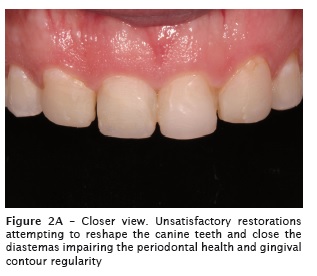
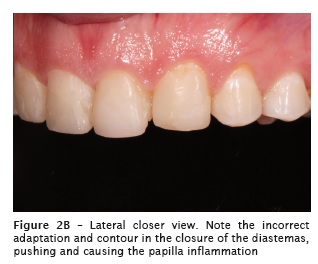
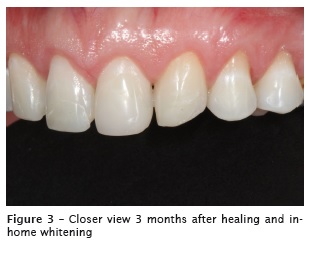
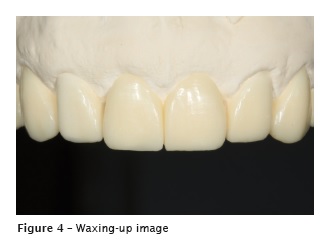
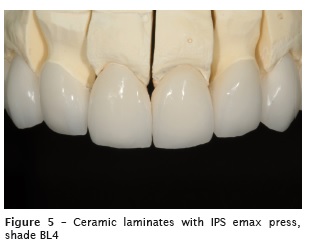
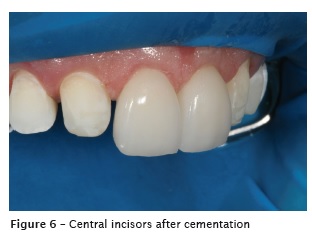
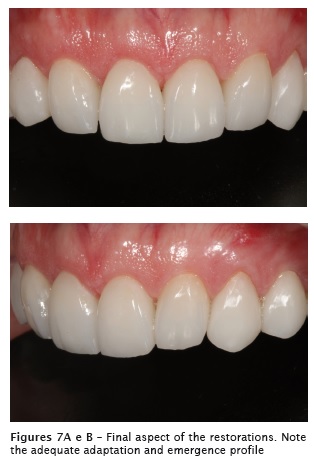
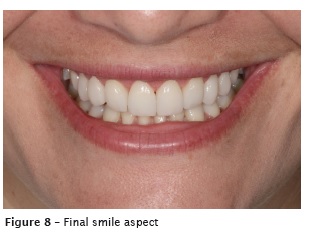
Discussion
To reach the dental esthetic excellence, different treatments or materials are available. However, regardless of the adopted treatment planning, caution should be taken to instruct the patient regarding all advantages and disadvantages of each treatment, and possible limitations, so that the patients' expectations are not frustrated because the treatment motivation is mainly due to unsatisfactory esthetics 9, resulting in great expectations.
The Periodontics is greatly allied with Operative Dentistry to obtain good outcomes because the gingival health and harmony are essential for the esthetic success. In the case reported here, the periodontal health was impaired by the presence of maladapted restorations that enabled biofilm accumulation and pushed the gingival papillae causing inflammation. The irregularity of gingival height caused disharmony. The periodontal treatment, the scaling, removal of the factors for bacterial plaque accumulation, and gingival recontouring favored esthetics, made the impression procedure easy, and enabled the construction of the ceramic laminates 5,8,10 with better adaptation and emergence profile improving the health and esthetics of the gingival papillae.
Other important factor was the possibility of not constructing provisional restorations because these may account for bacterial colonization and consequently periodontal tissue inflammation and esthetic alteration. When provisional crows were required, they must have good adaptation and polishing. The patient should be carefully instructed to perform oral hygiene, especially at the provisional crown stage 7,10.
The need of esthetically rehabilitation of the smile requires many teeth to be restored, and in these situations, the ceramic laminates were an interesting option because of the indirect preparation, anatomic ref ining, and better adaptation of the proximal and cervical areas 11. The dental ceramics increasingly evolved over the last years, which enables a significant improvement in the possibilities and indications of the indirect restorations, such as laminates, onlays, or full crowns, allying good resistance, color stability, and excellent optical properties 2. The proved evolution of both the dentinal and cement adhesive systems, contributed for spreading the indirect techniques as safe and reliable at the long term 1,13.
It is fundamental to highlight the importance of evaluating the patients' expectations and the understanding of the possible therapeutic solutions before starting any treatment planning 4. A careful planning should capture the patients' need and report the different treatment possibilities, with the advantages and disadvantages.
Conclusion
The ceramic laminates have adequate physical properties, excellent esthetic, longevity, and enabled a conservative treatment when well indicated, especially when associated with periodontal treatment.
References
1. da Cunha LF, Furuse AY, Mondelli RF, Mondelli J. Compromised bond strength after root dentin deproteinization reversed with ascorbic acid. J Endod. 2010 Jan;36(1):130-4. [ Links ]
2. da Cunha LF, Furuse AY, Yamashita C, Mondelli J. Tratamentos restauradores indiretos e a importância dos aspectos periodontais. Full Dentistry in Science. 2011;2(6):186-9.
3. de Waal H, Castellucci G. The importance of restorative margin placement to the biologic width and periodontal health. Part II. Int J Periodontics Restorative Dent. 1994 Feb;14(1):70-83.
4. Fradeani M. Reabilitação estética em prótese fixa – análise estética. v. 1. Quintessence; 2006.
5. Henriques PG, Nunes Filho DP, Nunes LFP, Nunes MPN. Atlas clínico de cirurgia plástica periodontal e manipulação de tecidos moles em implantodontia. São Paulo: Santos; 2007.
6. Kina S. Equilibrium – cerâmicas adesivas case book. São Paulo: Artes Médicas, 2009.
7. Lindhe J. Tratado de periodontia clínica e implantodontia oral. Rio de Janeiro: Guanabara; 1997.
8. Mondelli J. Estética e cosmética em clínica integrada restauradora. São Paulo: Santos; 2003.
9. Roberson TM, Heymann HO. Sturdevants art and science of operative dentistry. St. Louis, Missouri: Mosby Inc; 2002.
10. Rufenacht CR. Princípios da integração estética. São Paulo: Quintessence; 2003.
11. Shenoy A, Shenoy N. Dental ceramics: an update. J Conserv Dent. 2010 Oct;13(4):195- 203.
12. Spina DRF, Grossi JRA, Cunali RS, Baratto Filho F, da Cunha LF, Gonzaga CC et al.. Evaluation of discoloration removal by polishing resin composites submitted to staining in different drink solutions. International Scholarly Research Notices. 2015;2015.
13. Van Landuyt KL, Snauwaert J, De Munck J, Peumans M, Yoshida Y, Poitevin A et al.. Systematic review of the chemical composition of contemporary dental adhesives. Biomaterials. 2007 Sep;28(26):3757-85.
 Corresponding author:
Corresponding author:
Orides Ferrari Jr.
Rua Santa Catarina, 65, sala 811, bloco B
Água Verde
CEP 80620-100
Curitiba – PR – Brasil
E-mail: oridesferrarijr@gmail.com
Received for publication: April 14, 2016
Accepted for publication: September 22, 2016













